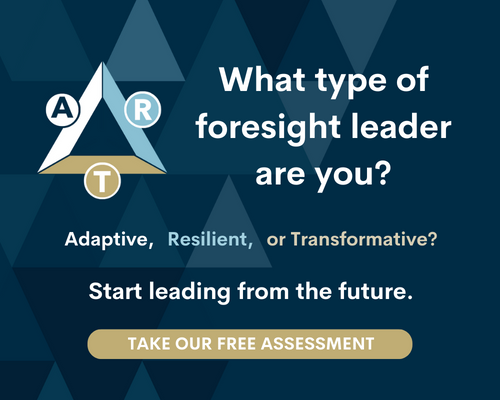The Future of Artificial Intelligence (AI)
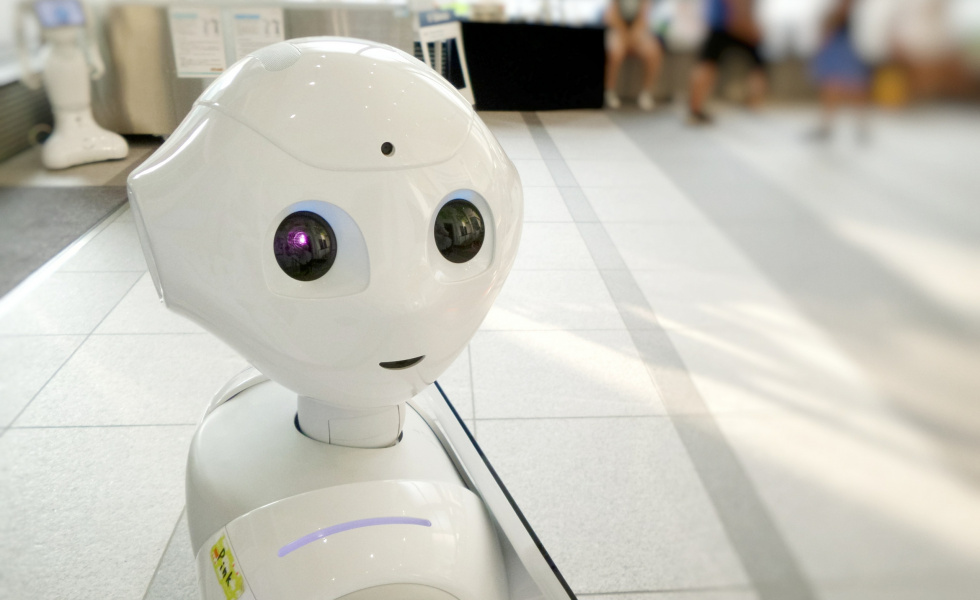
An abundance of questions surrounds the future of AI. Is it a threat or opportunity? Will it destroy or enhance humanity? How will it affect politics, laws, jobs, health, transportation, business and other facets of our lives? Will our AI future bear more resemblance to a utopian unfolding of The Jetsons or develop into the dark, dystopia displayed in The Terminator? AI technology promises to alter every industry and field as it transforms our individual lives – and even possibly our deaths. The rise of AI and introduction of new technologies such as quantum computing will drastically transform the world around. Through the use of Strategic Foresight tools and techniques we can anticipate the changes that lie ahead and focus on creating desirable AI futures and setting the scenarios and action plans needed to achieve them.
Preparing for AI
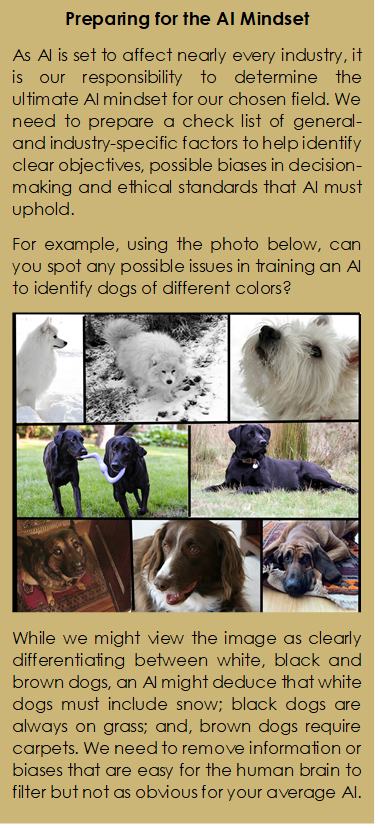
Before embarking on foresight activities, we must understand the challenges involved and adopt a framework and mindset to move us in the direction of desirable AI. AI is in many ways a foreign land with possibilities of both promise and peril. Designing our AI Futures is like organizing a trip to a foreign country. We need to determine our destination, decide which venues to visit, and prepare for the unexpected along the way.
Taking a trip requires us to understand what possible destinations we can arrive at. AI claims three possible destinations: Applied AI, AGI and ASI. Within a short time frame, almost every industry that hasn’t arrived at the “Applied AI” stage will get there. Here, AI excels at problem solving for specific tasks. At this level, AI abilities are identical or superior to a human. (For example, AI’s ability to personalize your Netflix recommendations). The second stage, Artificial General Intelligence (AGI) would enable AI to carry out any human level activity including the ability to understand emotion. Some experts claim that we are 10-50 years away while others insist that this time frame is unrealistic as we still need to overcome large technological gaps to achieve this level. The ultimate level of AI is called Artificial SuperIntelligence (ASI) and refers to computers as having abilities that exceed those of humans. This level of technology is considered most alarming but, at best, will only be available in the very distant future. No matter what level we are moving toward, when working with AI, we must set super clear and unambiguous goals so that machines can understand our true intentions without misinterpretation.
The journey venues are the use cases we define for AI technologies at the different destinations. When analyzing use cases, we must understand how we make decisions today. Our natural decision-making process is not precise, there are conscious and unconscious factors that guide us to make choices. Unlike our natural decision-making processes, the objectives we provide for AI must be explicit and rational. For example, when we choose a new shirt we might claim we are buying it because green suits us when the truth is that we just saw a movie in which our favorite star was wearing green. We are not always aware of all the factors that bring us to different purchase journeys or other actions we take. If we are not aware of our true objectives, how can we train an AI to understand them? We must improve our understanding of unconscious biases and what drives them.
It is imperative that we remove both the obvious and hidden biases that might transfer from our current systems and evaluate the morals that AI needs to demonstrate. Ethics in AI is a major issue and ethical training of AI is necessary to guarantee our safety and security.
Unexpected events historically occur when two or more fields of knowledge not only advance but also combine forces to introduce unforeseen changes. The combination of quantum computing and AI would advance both fields at highly exponential rates as superior computing abilities would augment the analysis of big data that AI is currently based on at incomprehensible rates. This is a major game changer which may enable researchers the insights needed to bring us closer to AGI development. Yet, prior to setting out on this journey, we need to make sure we are prepared for what we might encounter.
Scanning for Patterns
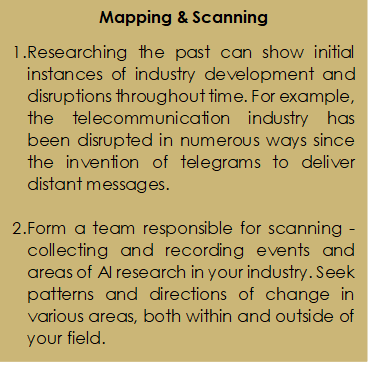
The changes that AI will unveil are so profound that it has been coined as the 4th Industrial Revolution. Once we determine the use cases and ethical values that AI might have, gathering past information reveals historical patterns of change and present trends influencing the field. We can identify relevant events and changes throughout the previous three revolutions and industry-specific reactions to disruption. Scanning and mapping these events lead to identifying patterns of change which help us gain an understanding of the possible directions industry changes may take. For example, someone in the human resource field would check what types of jobs were lost and which new jobs appeared.
AI patterns are evident – machines originally sought to reduce physical risk while carrying out routine tasks in the external environment. Yet, AI currently probes inward by offering more internal and personal solutions. For example, gene editing, digital telepathy or medical AI data collection devices. So, we can see a general pattern of AI moving inwards both on a biological and behavioral level of understanding what makes us tick.
Developing Scenarios & Action Plans
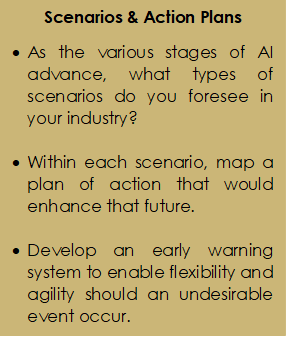
AI scenarios must incorporate how AI’s future understanding includes so many aspects of our lives – for example, our bodies, minds, tasks, homes, social contacts, cities, and transportation. No wonder science fiction writers wrote scenes where AI dominates humans! Yet, there are also an abundance of improvements that AI offers where we control AI technology to improve life span, mobility and other elements of everyday life. Or, might AI robots become our partners in creating a brave new world of assistive technology in which AIs carry out tasks that they are better at, leading us to work side-by-side? Perhaps a transhuman form of life will emerge combining AI and humans as the two forms further interact and become one. Consider how your industry may evolve for each of these possible scenarios. Use these insights to develop a strategy to calculate not only what AI might help us achieve in our industry, but also what precautions we need to take to avoid undesirable futures.
Summary
Society faces numerous hurdles ahead. The negative science fiction images of AI can aid us to develop strategic warning systems to avoid possible danger zones while more positive images can be used to guide us toward positive futures development. Issues such as data security, privacy rights and ethical considerations need to be fully developed to lead us to our chosen destinations. Strategic Foresight allows us choose the optimal journeys and destinations in anticipation of the future AI world ahead.

Iris Stein
Competitive Intelligence & Strategy Analysis Manager, Amdocs
Global Foresight Advisory Council Member
With over 15 years in the trenches, Iris combines her experience in competitive intelligence and strategy formation in her determination to help forward-thinking organizations achieve the agility and flexibility needed to succeed in today’s business world. Iris’ focus is on implementing strategic foresight by helping companies using emergent technologies, such as artificial intelligence, anticipate how to strategically prepare for disruption in their industry. She is currently working at Amdocs and implementing strategic foresight in the telecommunication industry. Iris’ personal interests include reading and hula hooping – but not simultaneously!

